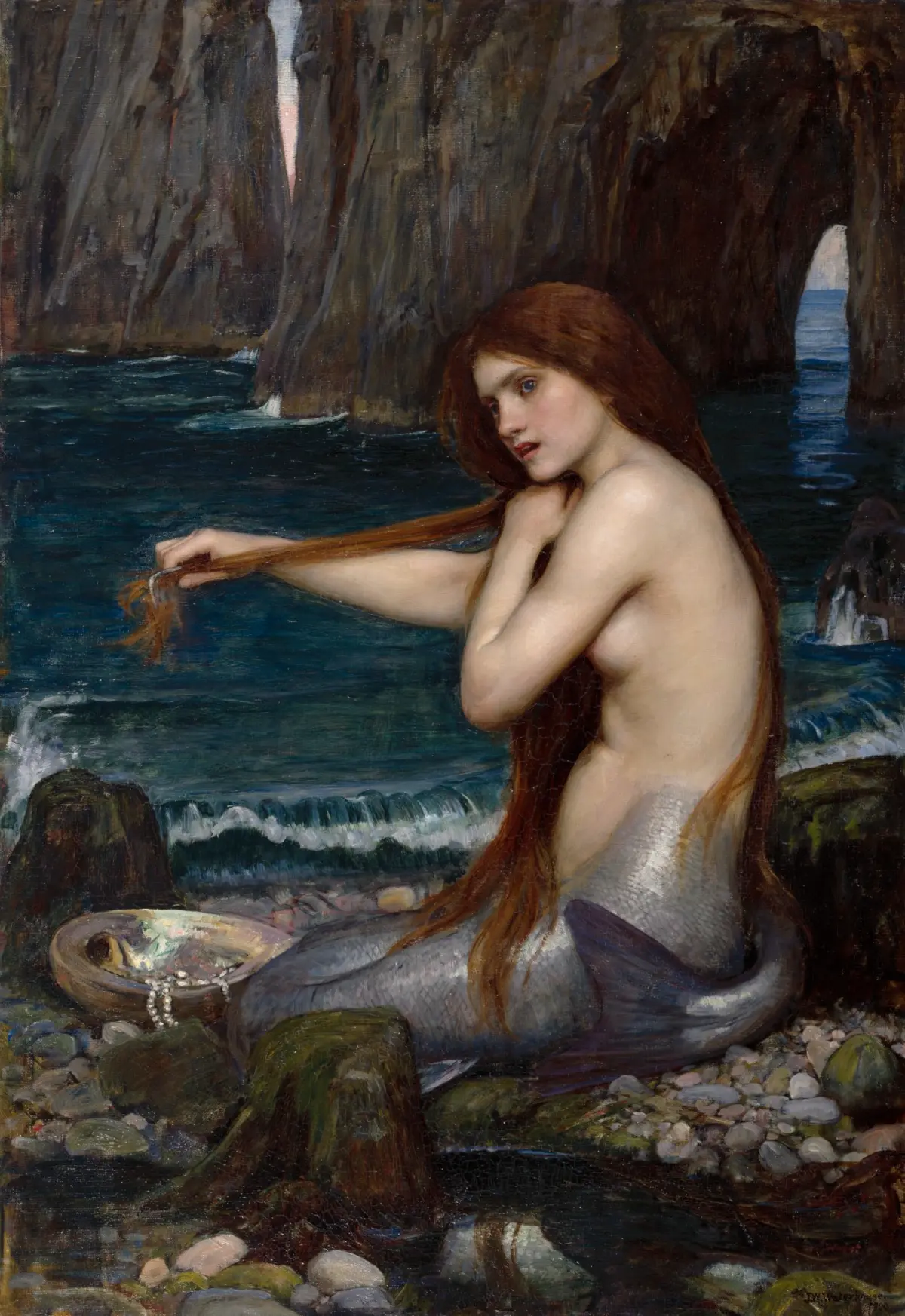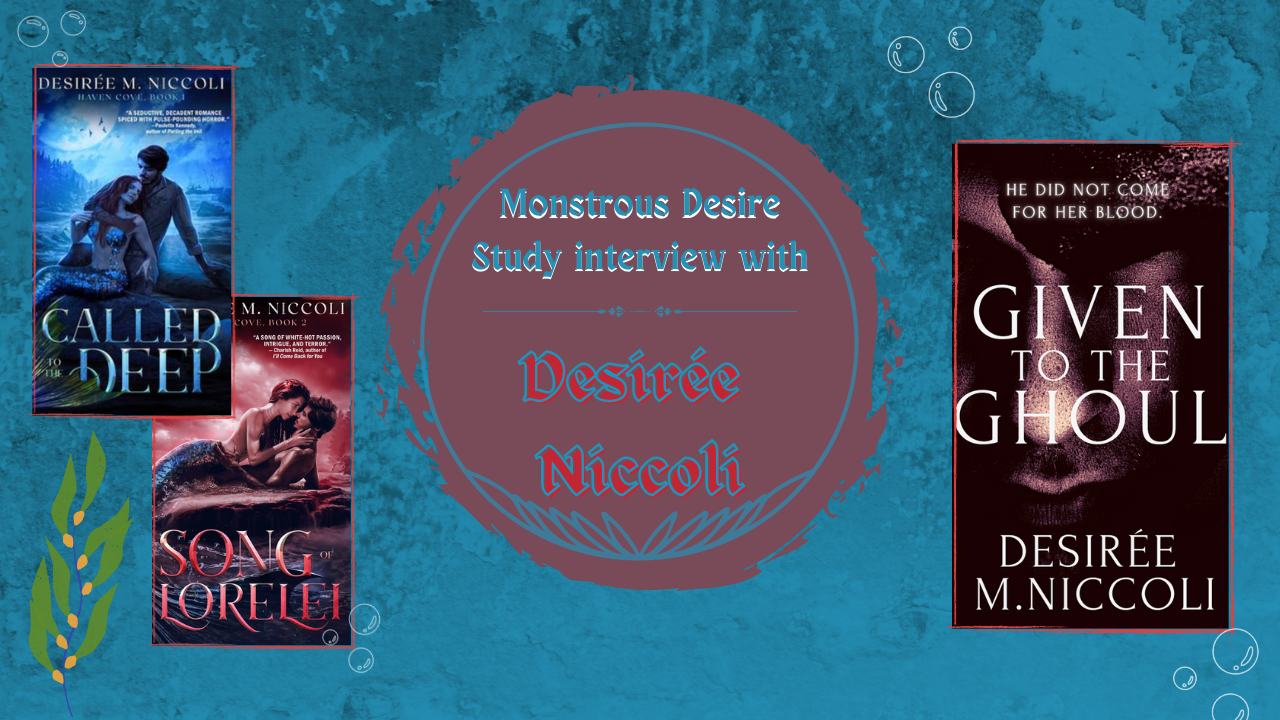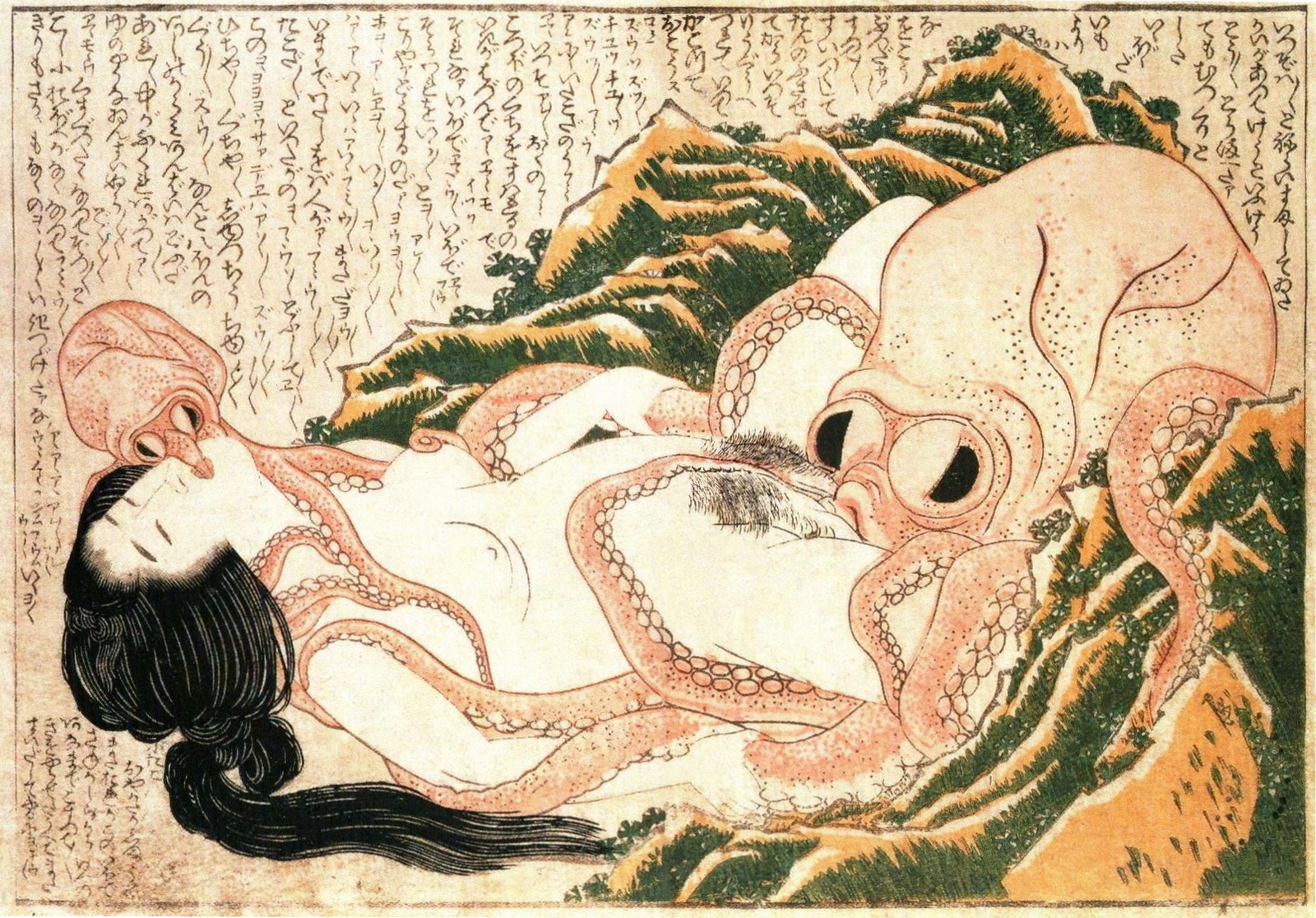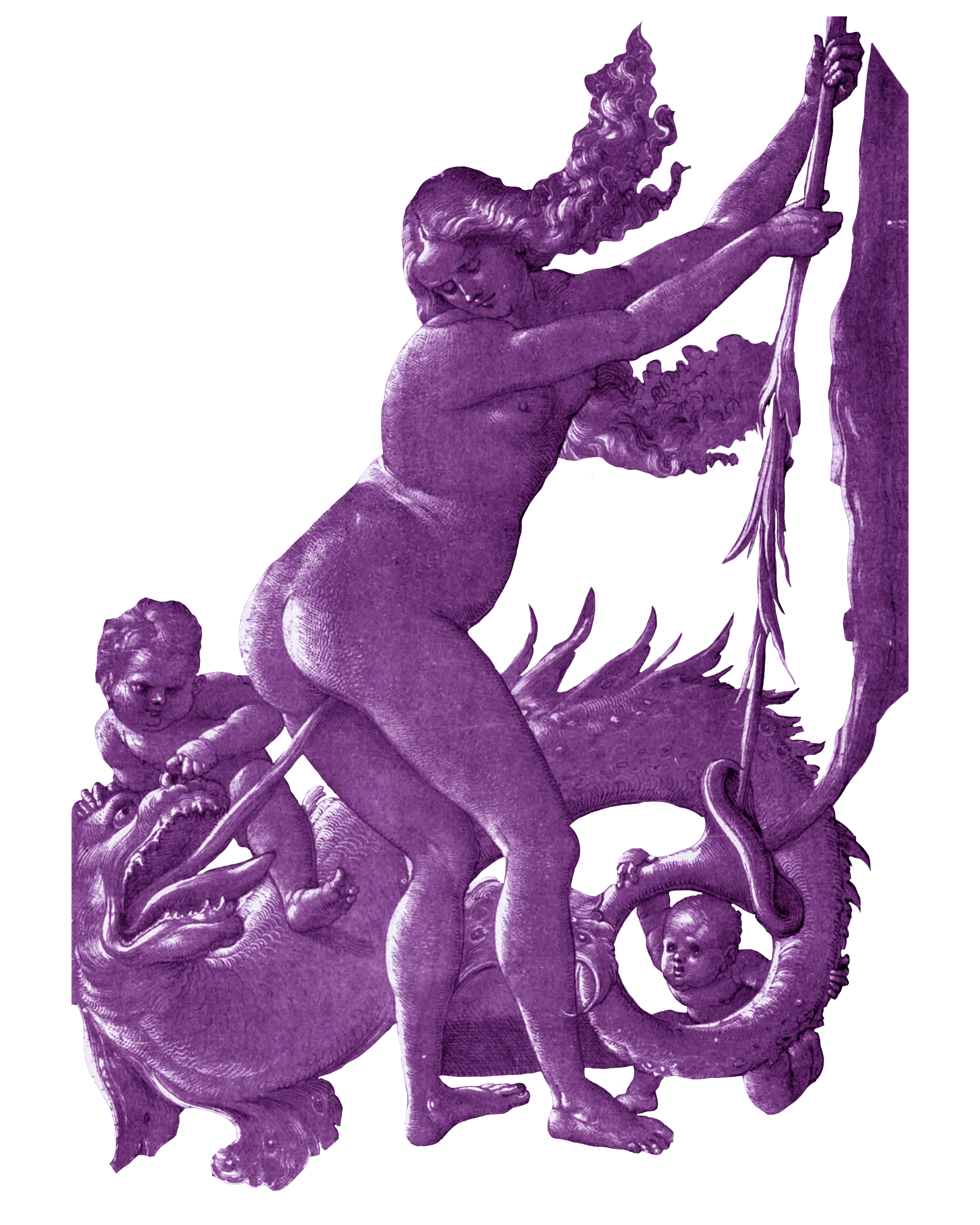Part 1 [T]he secret of the power in their song: it is the sound of the subversive, luring us from the orderly conscious world down to the depth of the world of dreams, and the harder we try to ignore that singing, the more we desperately want to hear it. —Meri Lao, Seduction and the Secret Power of Women: The Lure of Sirens and Mermaids Ah, the mermaid. The mermaid is a timeless figure who still persists within our cultural imagination today: from Disney’s Little Mermaid (1989)—which grossed more than $6 million during its first week in theaters and is currently being remade into a live-action version—to Starbucks split-tail logo, she is an instantly recognizable creature from her long, flowing hair to her sparkling fishy tail.1 Our obsession with the mermaid has transplanted her firmly within lore globally; where there is a body of water—from rivers, to lakes, to lochs, to oceans—you can bet yourself that the locals within the region have one story or another about a beautiful and alluring fish-woman swimming in its depths. As we continue forward during this glorious month of MerMay, we’ll examine the role of the mermaid and her siren call throughout both time and across the globe. Perhaps one of the oldest and most recognizable erotic monsters, the mermaid is a fascinating figure of paradox: she is both sexually tempestuous and unattainable; a symbol and provider of luck, as well as a harbinger of destruction. It’s for this reason that the Monstrous Desire Study rejoices as we continue to take a look at the mermaid and the eroticism that is inherent to her identity. Who is the Mermaid Today? The history of the mermaid is a long, and complicated, one. Depending on where you are in the world, her physical appearance and the historical point of her birth varies. As so eloquently stated by Gwen Benwell and Arthur Waugh, authors of Sea Enchantress, “Nearly every country has its mermaid lore; if the sea does not wash its shores, then its rivers, lakes or wells are likely to have their mermaid traditions”.2 From Africa, to Asia, to the Caribbean, to Europe, and the Americas, the mermaid splashes about in various bodies of water, granting wishes for or enacting harm against travelers who stumble across her. Yet, these mermaids were very different from the creature we know today. These mermaids of a not-so-ancient past were sculpted from raw nature: their intense beauty and intoxicating voices a mere mirage that hid the very danger and power that caused men to welcome a watery death. Today, the modern mermaid has been co-opted by capitalism as a merchandising tool. Their beguiling but dangerous power and beauty, possessed in both physical form and voice, has been relinquished in favor for a more palatable perception that can safely situate the mermaid on the front of children’s lunch boxes, beach towels, coffee corporation logos, and as toys. As Skye Alexander summarizes, “Hollywood and Madison Avenue have tamed the mermaid”, however, the taming of the mermaid had begun to take place prior to Disney.3 Instead, it was Disney’s beloved musical animated film that was the final nail in the mermaid’s watery coffin as a merchandise symbol. Finn Hauberg Mortensen outlines the historical transformation of the Western mermaid and her gradual commodification as a long chain of references that have defined the mermaid as a locus of cultural meaning, [that] can be divided into three layers: 1) the feudal-popular-pagan traditional culture with its superstitious sailors and folk ballads with sea creatures, 2) the bourgeois-Christian culture to which to which both [Hans Christian] Anderson’s fairy tale and Erikson’s statue at Copenhagen’s harbor belong and 3) finally, mass culture with its multi-media exploitation of Anderson’s fairy tale, the most characteristic example of which is Disney’s postmodern musical animated film. 4 Layer three is no less true today: at the time of this blog post’s publication, Disney is set to release the live-action version of The Little Mermaid, just one of a variety of live-action remakes from Disney’s musical animation library. The ramifications for the “Disneyfication” of the mermaid has diminished her mystique, “partly because she’s omnipresent now instead of rare…Unlike her sultry, siren ancestors, the modern mermaid is safe—and it seems we prefer her that way”.5 But, what was the mermaid like before Hans Christian Anderson’s fairy tale, Walt Disney, or before she became a politely-smiling logo for Starbucks? A (Not So) Brief History of the Mermaid Though the Western mermaid takes forefront within our cultural understanding of the mermaid, much of the mermaid’s lore can be traced back to ancient mermaid myths from Africa, India, and the Middle East.6 Before the modern mermaid and its ancestor the siren, there was the Babylonian god Ea, Lord of the Waters. The first merman in recorded history, the fish-tailed God was adopted by the Babylonians from the Akkadians. Ea is so old that worship of him can be traced back in Akkad to as early as 5000-4000 B.C. Ea not only controlled the sea, but the spirits and demons who dwelt under the surface. His portrayal is varied: in some instances, Ea (or, as he was also commonly referred to as, Oannes) is sometimes represented as human until the waist and possessing a fish-tail; in other portrayals, he’s shown to be wholly human and wearing a fish head and fish skin cloak that hangs down his back.7 Depiction of Ea, or Oannes The Babylonians, in fact, were the first to create the earliest-known depiction of a mermaid via sealstones which they used to “sign” documents by pressing carved stone images into hot wax. One such 18th-century sealstone portrayed a half-human, half-fish creature, perhaps to represent Ea in his merman form.8 In Syria, the moon-goddess Atargatis’ entire body was that of a fish, except for her human head. Atargatis—also referred to as Derketo by the Greeks—dealt with all things fish: Syrians abstained from eating fish in her honor, and could not eat them without a license issued
Interview with Desirée Niccoli
To kick off this Mer-May, I sat down with the wonderful Desirée Niccoli to talk about all things monstrous mermaids and their allure! Desirée is the author to the Haven Cove series, multiple short stories, and the novella Given to the Ghoul! If you’d like to read her work, or become more acquainted with her titles, you can do so here: https://dmniccoli.com/. Apologies for the poor lighting in my video; one day I will master both sound AND video, but it is not today.
Sucker for Tentacles: The History of Japanese Erotic Tentacle Play
Part 1 Content Warning: this essay contains descriptions and discussions of assault and rape, as well as explicitly sexual images. With its tentacles, the horrible beast sucks the tips of her breasts and rummages in her mouth, while its head drinks from her lower parts. The almost superhuman expression of agony and sorrow—which convulses this long, graceful female figure with aquiline nose—and the hysterical joy—which emanates at the same time from her forehead, from those eyes closed as in death—are admirable. —French novelist Joris Karl Huysmans describing Hokusai’s “Diver and Two Octopi” Whether or not you consider yourself a monster fucker, or someone merely interested in the topic, you’ve probably heard of tentacle porn, or tentacle play. The genre has become increasingly more popular in Western media, finding itself at the forefront of many titillating popular monster romance novels like Katee Robert’s The Kraken’s Sacrifice or Lillian Lark’s Stalked by the Kraken. Yet, Western media’s fascination with erotic tentacle play is a newfound phenomenon, the genre having only been imported from Japan within the last few decades. Rather, the history of erotic tentacle play within Japan not only precedes contemporary manga, where the genre gained global significance, but can be traced through Japan’s art history as far back as the Edo-period. This week, the Monstrous Desire Study examines why we’re suckers (heh, get it? Suckers? Because tentacles have suckers?…Ahem. I’m done) for tentacles and their historical relevance within art history and culture! What is Tentacle Play? Tentacle play, also known as “tentacle rape”, conjures up images of great, writhing, lubricious tentacles that bind, squeeze, and penetrate a wriggling person who is, more often than not, a woman. Its definition, however, is as slippery as its content. Kimi Rito, author of The History of Hentai Manga: An Expressionist Examination of Eromanga characterizes modern-day tentacle play/rape as a genre that “usually involves a monster or mysterious life form with tentacles playing with a girl’s body, usually developing into a scene where said woman gets violated by those tentacles”.1 This definition, however, delineates tentacle play through the taboo of violation. Though Rito’s definition fittingly contextualizes tentacle play in eromanga, rape and violation do not always take place in tentacle play. In Katee Robert’s The Kraken’s Sacrifice, for example, the female protagonist is never violated by her demon-kraken lover; in fact, consent is emphasized repeatedly throughout the narrative and the use of tentacles for sexual pleasure is enthusiastically welcomed.2 Instead, I would like to tweak and build upon Rito’s definition to instead categorize tentacle play as not a woman being violated by tentacles, but rather, a person receiving pleasure from tentacles. This definition not only broadens tentacle play outside of the context of eromanga, but highlights the key differences in the evolution of the genre as it expanded to more global audiences. As such, I will oscillate between the terms “tentacle play” and “tentacle rape” to distinguish the difference’s within the genre concerning consensual sexual pleasure and rape. This is not to Other tentacle rape through an Orientalist gaze: rape-play does exist within Western erotic media, and is a popular trope within the erotica genre, especially within the sub-category of Dark Romance. Rather, the differentiation between “tentacle rape” and “tentacle play” is important when examining the genre’s shared attributes as well as their categorical deviations. Print of post-sex from Kinoe No Komatsu, Katsushika Hokusai (1814) With that being said, when defining tentacle play, we cannot do so without first examining its role in eromanga, as well as its historical presence in Japan’s art history. Beloved tropes in eromanga, such as the “cross-section view”—or, an illustrated view of insertion during sex that helps visualize the hidden or inner workings for the audience—and close-ups, would not have the cultural relevance that they possess currently without the influence of art styles like shunga during the Edo-period.3 (Also, sidenote: this print is so surreal. A creampie? In my art history? It’s more likely than you think!) By tracing the historical trajectory of Japanese art history, this not only helps to contextualize the framework through which eromanga’s tentacle play emerged from, but the three main conditions that Rito outlines to characterize tentacle play/rape: Regardless if it is a living organism or not, it will have long, narrow, sinuous limbs that can move freely. These limbs will work independently, as if having a will of their own, and the owner of these limbs can operate them from long distances. One can clearly tell that the woman (or sometimes, man) being attacked feels pleasure. The purpose of the attack is sexual assault, with the victim’s will being violated, and the reader can understand this clearly.4 The History of the Abalone Diver: Shunga and Tentacle Play Much of Japan’s erotic art is motivated and shaped by censorship. Before the conception of eromanga, Japanese artists during the Edo-period (1615-1868)—also known as ukiyo-e artists—found their proverbial hands tied by visual art restrictions. Though printed materials were only a small portion of the crackdowns during each censorship period (the Kyōhō reforms of the 1720s, the Kansei reforms of the 1790s, and the Tempō reforms of the 1840s), this still included the visual arts. The censorship reforms banned all sexually explicit works, forcing sexually explicit books and prints to be published under pseudonyms or artist signature omission.5 It appears that the people of Japan—men and women, young and old, from a wide range of class statuses—were not going to let the restrictions inhibit either the production or acquisition of shunga, or, erotic woodprinting art. Scholars now speculate that the production and circulation of shunga was vast during the Edo-period, in spite of restrictions.6 However, because of censorship, ukiyo-e artists needed to produce art that bypassed the restrictions. This art was called abuna-e, or, “risky pictures”.7 “Risky picture” subject material featured the oh so scandalous imagery of “women entering the bath, trimming their toe-nails, playing coquettishly with pets or small children, fighting a strong wind or engaging in any other activity that allowed for titillating glimpses
Interview with Clio Evans
I sat down to chat with the talented and popular Monster Romance author Clio Evans! Clio is the author to beloved series and novels like Creature Café, Warts and Claws Inc., Doves and Demons, and The Scoundrel and the Satyr King (to name only a few!). We talk about all things erotic monsters, Sapphic representation in romance, and first monster crushes. If you’d like to read Clio’s work, or become more acquainted with their titles, you can do so here: https://clioevansauthor.com/
Carnal Desires and the Crisis of Belief: Demon Copulation in Europe and Witchcraft Accusations–Part 2
Part 2 Content Warning: this essay contains descriptions and discussions of assault and rape. [The presiding devil] might make love to her and have carnal knowledge of her: to whom he said maliciously that he would lay her down on the ground supporting herself on her two hands and feet, and that he could not have intercourse with her in any other positions; and that was the way the presiding devil enjoyed her, because at the first sensation by the neophyte of the member of the the presiding devil, very often it appeared cold and soft, as very frequently the whole body. –Quellen tract (1460) describing Arras witches and Sabbat Previously, I briefly discussed the context in which demon copulation occurred as well as traced the approximate timeline alongside the fervency of witchcraft theory in Europe during the Middle Ages. If you missed that blog post, you can read it here. Now, however, in part two the study is going to focus on the specificities of the accused’s confessions. In this blog post, I’m going to be looking at how the physical bodies of the demons and devils were described, including their genitalia, as well as how sex was described. Prior to 1570 There is a consistency to demon’s and devil’s physical descriptions by the accused that can be broken down into four categories: anthropomorphic, impossibly beautiful human, human with inhuman feet, and monstrous. The descriptor consistency can probably be attributed to the fact that interrogators relied upon scripted questions to bully or torture victims into confessing whatever aligned with and bolstered their vision for corporeal interactions.1 Because witchcraft theory, and thus demon copulation and the way it was portrayed, encountered a shift around 1570 due to a second wind of an even more fervent push against skepticism, the physical descriptions of demons and devils reflects this shift as well. Prior to 1520, and as early as the 1100s, demons were described as handsome and overtly beautiful. Merlin’s mother testifies to this in Geoffrey of Monmouth’s The History of the Kings of Britain in which she describes the mysterious incubus who visited Conception of Merlin, Bibliothèque Mazarine, Inc. 1286 her routinely in her chamber at night as “someone resembling a handsome young man” who “often made love [to her] in the form of a man”.2 It’s crucial to note here that Merlin’s mother does not state that she was visited by a man but rather something that resembled a man, indicating that she knew it was not human despite its beautiful disguise. Devil Seducing Witch, Konstanz ([1489?]) The 1523 theatrical book, Strix, sive de ludificatione daemonum or The Witch; or, On the Illusions of Demons, written by Gianfrancesco Pico della Mirandola, was based off of a witch trial that Pico had participated in. In the book, Strix, an accused witch, is being questioned and interrogated about her sexual encounter with a demon by three men. She tells the men that her demon lover, Ludovicus, had appeared in every sense as a normal man except for one small detail: his feet. They were those of a goose and reversed, so they pointed backwards.3 One such interrogator, Dicastes, explains the reason for this is because while the Devil can nearly create a “perfect facsimile of the human body” he can never truly get the feet right as God purposefully makes them come out inversos et praeposteros so that people are not fooled in the presence of demons and devils.4 When asked if Ludovicus had shown Strix any other kind of feet besides gooselike, Strix replies, “Never any other” and that he “Never [appeared] in any form but human if he intended to copulate with me”.5 The reality of this framing positions the accused as automatically guilty of sinning, as they have no excuse for knowing they had sex with unholy corporeal beings with such a dead giveaway. A similar confession took place in Germany in 1587, in which a licensed midwife named Walpurga Hausmännin, confessed to not only maleficia—harmful magic—but demonolatry, or sexual relations with demons. 31-years before her trial in 1556, Walpurga engaged in a one-night stand romp with a fellow worker.6 However, after having sex, Walpurga began to notice terrifying peculiarities about her lover Bis im Pfarrhof that pointed to him not being human at all, but the Devil: his feet were cloven hooves and one of his hands appeared “as if made of wood”.7 Walpurga realized with horror what she had done, however, this did not prevent her later the next night from having sex with the Devil yet again when he returned in the same form, and then later yet embarking on “a contiguous orgy of sexual excess” with the Devil.8 Demons, devils, and the Devil’s physical form, however, were often described in a manner that implied fluidity and genderlessness. According to theologian Thomas Aquinas, demons had no sex so that they could appear to their victims as either men or women.9 In Dominican Charles Rene Billuart’s angelology treaty, Tractus de Angelis, the Dominican wrote that: “The same evil spirit may serve as a succubus to a man; and as an incubus serve a woman”.10 This fluidity was thought to be motivated not by a desire for self-pleasure or joy—as, according to the French judge De Lancre, demons were incapable of feeling joy or pleasure——but a desire to degrade and humiliate man as well as a sole purpose of “lasciviousness”.11 This was due to the theory that demons and devils were unable to produce their own semen and so were forced to steal the fluid from men as succubus and later reuse the emission to inject within women as incubus. The genderlessness of demons was mentioned often by clergy and theologians, such as Francesco Maria Guazzo who, in 1608, wrote the Compendium Maleficium and stated that: For devils can assume the bodies of dead men, or re-create for themselves out of air and other elements a palpable body like that of flesh, and to these they can
Carnal Desires and the Crisis of Belief: Demon Copulation in Europe and Witchcraft Accusations
Part 1 Content Warning: this essay contains descriptions and discussions of assault and rape. [Theologians’] fantasy of witches’ corporeal ravishment translated their own desire for an overwhelming intellectual conviction, one that would annihilate their involuntary resistance to the idea of demonic reality Walter Stephens, Demon Lovers: Witchcraft, Sex, and the Crisis of Belief, 26 Though the study thus far has focused primarily on erotic monsters in media and popular culture from the 20th and 21st century, the influence of erotic monsters predates this time frame by centuries. As such, this week we’re going to look at the surreal and near-obsessive fixation Europeans had towards erotic monsters during the Middle Ages relying upon Dr. Walter Stephens’ theory of the “Crisis of Belief”, and the role erotic monsters played in witch accusations, sexuality, and the churches’ desperate need for religious rehabilitation. Overview During the Middle Ages, a persistent wave of hysteria washed over Europe. Across the continent, men, women, and children were accused of practicing or participating in witchcraft, these accusations based on both a complicated and variable number of motivations, not all of which were spurred by what many believe to be driven wholly by misogyny. A group of witches and warlocks dancing with the Devil at the Sabbath from Compendium Maleficarum, Francesco Maria Guazzo (17th Century) Christinia Larner asserted that though witch-hunting criminalized women as a group, “witchcraft was not sex-specific but it was sex-related” due to the “substantial proportion of male witches in most parts of Europe means that a witch was not defined exclusively in female terms”.1 Despite the erroneous assertion of radical feminists like Andrea Dworkin that approximated 9 million or more female victims died from witch-hunting, a more realistic figure is that approximately 30-60,000 victims of both genders died within 300 years.2 This is not to undermine the role of violent misogyny in witch-hunting. In the case of Scotland—who zealously took to witch-hunting more so than neighboring countries like England because Scotland appropriated the witch-hunting patterns established on the Continent3—of an approximate total number of 3,837 accused, 84% were women, 15% were men, and 1% were unknown sex.4 Witchcraft theorist books like the infamous Malleus maleficarum, written by Heinrich Kramer, outlined explicitly how women were naturally predisposed to evil and drew evilness to themselves through their insatiable lust. One such passage from the Malleus states: “Women do all things because of carnal lust, which…is insatiable in them. Wherefore for the sake of fulfilling their lists they consort even with devils” and that witches “indulge in diabolical filthiness through carnal copulation with incubus and succubus demons…devoting themselves body and soul [to devils].”5 The misogynist ideology concerning the corrupting lust of women was not conceived during the Middle Ages, but rather, can be traced back to Adam and Eve in which Paul states that “the serpent seduced Eve by his craftiness”.6 Eve’s corruptible desires laid the groundwork for misogynistic ideology decades afterwards, especially by church clergy like the theologian and bishop of Milan, Ambrose, who concluded that “if Eve’s door had been closed, Adam would not have been deceived and she, under question, would not have responded to the serpent. Death entered through the window, i.e. through the door of Eve.”7 Much like Heinrich Kramer, theologian and partial archbishop Isidore of Seville believed that the libidinous appetite of women was intrinsic to them, and that they were even named for it based on “the word femina” which derived from Greek to describe “the force of fire because her concupiscence is very passionate: women are more libidinous than men.”8 Yet, it was women’s supposed “libidinous” appetite that allowed the literate elite, specifically the church clergy, not only a closer proximity to corporeal beings, but provided the proof they were so desperate to reinforce across Europe. To iterate Dr. Walter Stephens’ hypothesis, misogyny was the catalyst rather than the ultimate goal of the church. Literate elite wielded misogyny so that they could exploit patriarchal oppression to “reinforce demonology—and, ultimately, a theology” to resist skepticism that demons, and other corporeal figures and spirituality at large, were not real.9 Misogyny, especially the “insatiable lust” of witches, was ideologically useful—necessary—in proving the physical existence of spiritual bodily contact through sensory data and bodily experience, as witches were the only ones who could identify demons and devils. Stephens contextualizes clergy and witch theorists as metaphysical voyeurs who necessitated the insatiable sexual desire of witches for legal proof of the existence of demons. Even Kramer admits that the function of the witch is to “make credible the notion that devils have regular bodily interactions with human beings”.10 Per Stephens: “Without a diabolophany, a shattering personal encounter with a demon, the need for belief in demonic reality could never be satisfied”.11 These religious anxieties were then violently forced upon the people of the Middle Ages in a need for constant reaffirmation, extracted through torture and force as “proof”, and reinforced as “truth” through witch theory treaties and literature. In fact, demonic copulation did not come about during witchcraft trials until the torture stage, many of which were scripted, to produce satisfactory answers for the interrogators that reaffirmed proof of corporeal relations.12 For the church, sex was a mode in which they would obtain not only irrefutable proof of demons, but knowledge of them as well. The more descriptive a witches’ “confession” about the physical body of their demon lover, or, carnal knowledge, the more tangible proof clergy had at the indefinite existence of demons and corporeal beings. Timeline This timeline is based on Dr. Walter Stephens’ research from the book Demon Lovers: Witchcraft, Sex, and the Crisis of Belief Visualizing a timeline helps to clarify and follow the shifting attitudes and witchcraft theologies that occurred between 1150 and the late 1700s. Though not widely believed, nor fervently enforced, demonology and angelology began to take form in 1150. Because the literate elite did not have reason for uncomplicated belief in angels, demons, and spirits, there was not a need for “scientific” exploration (as loose as the term scientific can be).13 However, this did not mean that demons did not exist within the culture at
Interview with Lillian Lark
I sat down with Monster Romance author Lillian Lark back in the Fall of 2022 to chat with her about erotic monsters, kinks, fantasy and its role in Monster Romance, and her interpretation of monsters! Lillian Lark is a popular romance author of novels like Deceived by the Gargoyles, Stalked By the Kraken, Entranced by the Basilisks, and Ensnared by the Werewolf. If you’d like to read her work, or become more acquainted with her titles, you can do so here: https://www.lillianlark.com/
Hypnotism Through the Decades: Dracula
[Dracula] had also to have an erotic element about him (and not because he sank his teeth into women)…It’s a mysterious matter and has something to do with the physical appeal of the person who’s draining your life. It’s like being a sexual blood donor… Women are attracted to men for any of hundreds of reasons. One of them is a response to the demand to give oneself, and what greater evidence of giving is there than your blood flowing literally from your own bloodstream? It’s the complete abandonment of a woman to the power of a man. Christopher Lee on playing Dracula Though not the first vampire of the Gothic genre (that title belongs to John Polidori’s The Vampyre (1819), ‘Varney the Vampyre’ in Varney (1845 to 1847), and Sheridan Le Fanu’s Carmilla (1872)), Dracula has maintained his hold in the public eye decades after the book’s publication by staking the desirous hearts (pun intended) of many people, especially heterosexual women. Because Dracula was mentioned 60 times when respondents were asked to remember who their first monstrous attraction was, this week we’re going to take a peek at the hypnotic allure of Dracula and the history behind this mysterious, sepulchral (and sometimes cape-wearing) character within film and television, from Bela Lugosi, to Christopher Lee, to Gary Oldman. Let’s set the stage: It’s 1931 and Hollywood executives at Universal Pictures are worried.1 With just two months until the release of Dracula, starring the intense-gazed (and wildly underpaid) Bela Lugosi, Universal was uncertain if the movie was going to be successful due to its unprecedented thrill and supernatural elements that had only previously been seen by American audiences through the chiller movie The Cat and the Canary (1927). Prior to the Stock Market crash, the movie had initially been intended as a sprawling epic, adapted from Bram Stoker’s novel. However, with the Great Depression’s shadow lengthening to touch any and all industries, execs worried that the movie adaptation would flop and so swung into a different direction, hiring Hamilton Deane, who had already adapted the book into a play. Movie poster for Dracula (1931) Though the movie was released prior to the Hays Code, the execs of Dracula perilously balanced between wanting to insert sensual tones into the movie to attract women to the film without being overt and explicit, and thus crossing over into being too suggestive. The inherently erotic subtext of vampire bites was broadly understood and recognized, so much so that Universal execs (unsuccessfully) fought against filming the scene in which Dracula attacks Renfield. The bite was perceived as queer, and so directors and writers were notified that “Dracula is only to attack women”. Furthermore, though bite marks would appear in the 1958 Dracula, starring Christopher Lee, Lugosi’s Dracula was not permitted to show the bite marks as it was deemed too suggestive.2 Dracula’s appearance drastically changed to be more alluring to general audiences as well. The 1922 German film Nosferatu portrayed the vampire as a grotesque creature, and even Stoker’s character (the source material!) vastly differed from what we associate Dracula with today: pale skin, dark hair, and altogether a “charming but deadly lover with hypnotic eyes”.3 Stoker’s Dracula, however, was an old man with “a long white mustache”4 who had a “lofty domed forehead, and hair growing scantily round the temples, but profusely elsewhere”, including the palms of his hands.5 Not so easy on the eyes. Yet it was Lugosi’s Dracula, and later Christopher Lee’s and Gary Oldman’s, that made his striking appearance so commonplace and recognizable. Having pitched Dracula as a swoon-worthy character, Universal began to market the film as “The story of the strangest passion the world has ever known!” in the hopes that women would overlook the storyline of a blood-sucking vampire in lieu of a love story, even releasing the film on Valentine’s Day. A promotional poster for the movie printed in The Tyler-Courier Times in Tyler, Texas headlined the movie with “The Caress No Woman Can Resist!” (right). Universal’s marketing strategies—including publicity that audience members had fainted in horror while watching the movie—were a hit: Dracula, for all its gambles in sensuality and horror, made the largest profit of Universal’s 1931 releases, grossing $700,0006 and precipitating a boom of horror films during the 1930s.7 Lugosi would also become a sensational hit with Dracula’s popularity. Thrust into the spotlight, Lugosi was perceived with a complicated mixture of fear and attraction. In a Motion Picture Classic Magazine interview, Hungarian actor Lugosi explained his sensational appeal: Dracula (1931) movie promotional in the Tyler-Courier Times (Tyler, Texas) 12 April 1931 “When I was playing Dracula on the stage, my audiences were women. Women. There were men, too. Escorts the women had brought with them. For reasons only their dark subconscious knew. In order to establish a subtle sex intimacy. Contact. In order to cling to and feel the sensuous thrill of protection. Men did not come of their own volition. Women did. Came–and knew an ecstasy dragged from the depths of unspeakable things. Came–and then came back again. And again. Women wrote me letters. Ah, what letters women wrote me. Young girls. Women from 17-30. Letters of a horrible hunger. Asking me if I cared only for maidens’ blood. Asking me if I had done the play because I was in reality that sort of Thing. and through these letters, couched in terms of shuddering, transparent fear, there ran the hideous note of hope. They hoped that I was Dracula. They hoped that my love was the love of–Dracula.”8 Vampires were not new to cinema in 1931, however, it was Lugosi’s aristocratic charm and his conventionally attractive human exterior that concealed his evil supernatural identity that proved most influential to the genre for decades to come, especially erotically. The cape wasn’t the only thing that would be forever associated with Dracula because of Lugosi: the classic vampire would be defined by being “thoroughly evil, but by virtue of his powers—physical, mental and, by implication, sexual—he is able to captivate and control others, especially women.”9
Why’d ya spill yer beans?
The Beginning The night I first watched The Lighthouse, the rain had polished the streets of San Francisco shiny, reflecting storefront neon lights and rainbow-edged, oily puddles. As I waited for a friend to find parking (his irritation giving way to rage the longer he looped round and round the block), I sat in a tiny independent movie theater lobby. The theater was sandwiched between Korean markets with green awnings, ripe produce displayed out on the street for all to see like jewelry in a storefront window. The lobby was no bigger than the cramped San Francisco apartment rooms landlords charged ungodly amounts of rent for, its dark red carpet worn from decades of shuffling feet who had come in from the rain, the fog, the (more scarce) sun, eager to watch movies. Behind what could only be deemed a cubicle-sized snack bar, a young worker popped popcorn and waited for whatever crowd would emerge that night. I sat there, waiting, unaware of the impending obsession the movie we were about to see would trigger in me. Unaware of the trajectory it would shove me headlong towards. Instead, I started the movie without my friend (who, by now, was cursing the very name of San Francisco and all its inhabitants in his desperation to still find parking). The first bone-shaking blare of the foghorn and the shrill whine of the soundtrack set my body rigid. My muscles would remain in that fixed state for the rest of the film, despite its crass and shocking comedy, its titillation, its horror. When the film ended and the lights came back on, I was released from my trance and my friend and I stumbled back out onto the streets, my stomach uneasy. I had never felt so breathless, so unnerved after a movie, and I would remain so for weeks afterwards, the image of writhing tentacles, hungry mermaids, and mad lighthouse keepers vivid in my mind. I was still in the (glass) closet at this point in my life, though, I’m certain that the only person who I was fooling was myself, and even that was becoming undeniable, the delusion untenable. It was for this reason that The Lighthouse spoke so viscerally to me. To watch Winslow struggle through his identity as it metamorphosed into something of an unspeakable horror that repelled and magnetized him; and that not only chased him, but devoured him in the end. So too would my own obsession with monstrosity become a specter that haunted me, a madness that chased me through the pandemic while others dealt with quarantine in more conventional ways like roller skating and bread baking (though I did try—and fail—that as well). I devoured countless books, made sliding scales and graphs, anything to attempt to satiate my burning curiosity to understand the evocative connection between monstrosity and eroticism. And yet, despite the years it has been since that quiet, rainy evening in San Francisco, I have still not yet found peace. That is just the nature of monstrosity, as monsters are, as Jeffery Andrew Weinstock synopsizes, ‘a kind of language, a way to give symbolic shape to and communicate affect and experience’. This study and book, then, is in large part self-preservation: a way to crack open my skull and spill forth the language of monstrosity, its allure, its perversion, before it tries to devour me whole. This book is for anyone who finds themselves drawn to monsters as well, or even those who, on occasion, found themselves confused by the titillation terrifying creatures had on them. I welcome all who join me on this journey as I wade through the overwhelming amount of data the survey provided, the countless historical and cultural books I will read, the interviews I will watch and carry out with monstrous authors, and any other epiphanies that strike me through the research portion of this study. Thank you for your support and enthusiasm. With love– E








